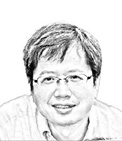TCM museum in US introduces Chinese healing art to Westerners
THE purple cupping dots on the back of legendary American swimmer Michael Phelps during the 2016 Olympic Games in Rio de Janeiro helped cast traditional Chinese medicine into the international spotlight.
The much-publicized story convinced many around the world of the effectiveness of Chinese healing techniques. But TCM is on the whole still shrouded in mystery in the eyes of many Westerners.
The Chinese Medicine Museum in Rockville, in the US state of Maryland, is an ideal place for Westerners to learn more about TCM.
It features a display, about 2,000 square meters, of herb formulas and non-pharmacotherapy treatments.
It may be hard for the museum to convince non-believers of TCM immediately, but it may help remove doubts among visitors about the effectiveness of TCM.
“TCM is actually a science,” says Ji Bo, a TCM professor in Maryland’s TCM center. “And its clinical trial has started thousands of years ago.”
The museum, affiliated with the Beijing University of Chinese Medicine’s US research center, is a non-profit institution that opened to the public in 2016.
“We hope by taking a tour of the museum visitors can get to know the culture, theory and therapy of TCM,” says Ji, who is now in charge of the museum. “Beside, we are also hereby presenting some achievements of TCM studies on the international stage.”
Upon entering, a statue dotted with acupoints may attract the attention of visitors. To those who are familiar with the history of TCM, the statue evokes a life-size bronze statue designed by Wang Weiyi, a pioneer acupuncturist in the Song Dynasty (960-1279).
Wang used a statue to help his students learn to accurately locate each acupoint by filling the statue with water and sealing it with wax, and let his students apply acupuncture to the statue to see if the needle was inserted into the hole. The other objects on display are also intended to stimulate the interest of visitors in TCM.
A model TCM clinic features a pharmacist’s cabinet at the back. This is the place where visitors can learn about the composition of herbal formulas, and the principles and the role of each ingredient.
In producing a formula, the function of the medicine mainly comes from the “chief herb,” but it is used with some assistant herbs. The dose of the assistant herb, however, has to coordinate with its chief to help it function better, or to alleviate side effects.
That calls for experience from a doctor, of course, a reason why TCM has been long denounced as non-scientific.
Nonetheless, this healing art has been the main treatment for Chinese people over thousands of years and is gaining popularity in many places around the world with proven healing effects for different diseases.
The non-pharmacotherapy treatment of traditional Chinese medicine is a key part of the museum’s exhibits, which inform visitors about the trajectory of TCM’s development overseas, as well as some anecdotes, Phelps being one of them.
Another story worth mentioning involves US reporter James Reston. In 1971, when he came to China before Henry Kissinger’s famous trip, he was suffering from post-operative pain after surgery on his appendix. The Chinese doctors performed acupuncture to relieve his pain, and it worked. This event, somehow, sparked strong interest in TCM in the Western world.
“As a TCM doctor, I have seen many cases where Western medicines have proven ineffective while TCM works — depression, serious insomnia and post-operative complications, for example,” says Ji.
“In Western medicine here, we have seen greater acceptance and understanding and agreement in TCM,” says Maryland State Delegate Clarence Lam, also a physician at Johns Hopkins University.
“We are seeing more research has been done, more federal dollars have been allocated to complementary medicine. Chinese and Western medicine can certainly work together,” he adds.
Nowadays, there are more than 40,000 acupuncturists across the United States. Among 50 states, 46 have promulgated laws on acupuncture.
There is more to be done if TCM really wants to go international. The museum is ambitious in that regard.
“There is room for both Western medicine and TCM ... we need centers like this to highlight to our community the importance of Chinese medicine and introduce to everyone the options available to them as well,” says Lam.
- About Us
- |
- Terms of Use
- |
-
 RSS
RSS - |
- Privacy Policy
- |
- Contact Us
- |
- Shanghai Call Center: 962288
- |
- Tip-off hotline: 52920043
- µ▓¬ICPĶ»ü’╝ܵ▓¬ICPÕżć05050403ÕÅĘ-1
- |
- õ║ÆĶüöńĮæµ¢░ķŚ╗õ┐Īµü»µ£ŹÕŖĪĶ«ĖÕÅ»Ķ»ü’╝Ü31120180004
- |
- ńĮæń╗£Ķ¦åÕɼĶ«ĖÕÅ»Ķ»ü’╝Ü0909346
- |
- Õ╣┐µÆŁńöĄĶ¦åĶŖéńø«ÕłČõĮ£Ķ«ĖÕÅ»Ķ»ü’╝ܵ▓¬ÕŁŚń¼¼354ÕÅĘ
- |
- Õó×ÕĆ╝ńöĄõ┐ĪõĖÜÕŖĪń╗ÅĶÉźĶ«ĖÕÅ»Ķ»ü’╝ܵ▓¬B2-20120012
Copyright ┬® 1999- Shanghai Daily. All rights reserved.Preferably viewed with Internet Explorer 8 or newer browsers.


